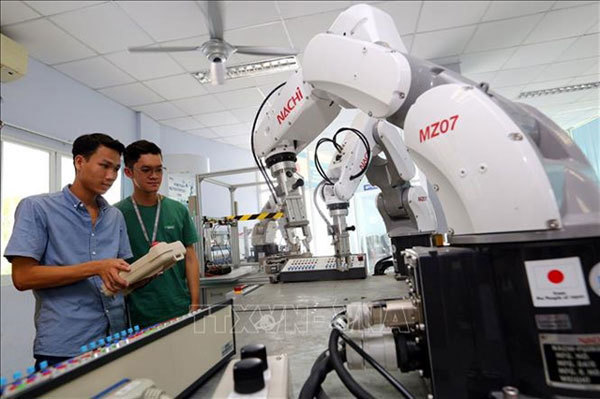 |
| Two students learn to operate a robot in Saigon Hi-Tech Park Training Center in HCM City.—VNA/VNS Photo (Illustrative image) |
Can you tell us about the vocational training network in Vietnam?
We have more than 1,900 occupational training establishments nationwide, of which 399 are colleges, 462 are secondary schools and more than 1,000 are continuing occupational and educational centres.
From 2017 up to now, each year, more than two million people have been trained and graduated from these centres. More importantly, more than 85 per cent of students attending these vocational schools have found employment immediately following graduation.
Vocational training activities have received attention from concerned agencies, particularly employers. As a result, it has become a hot topic in the vocational training network nationwide. This has raised the quality of Vietnamese workers to a higher level.
What are the challenges the vocational training network has faced?
Compared with the past, the number of students registered on vocational training courses has increased considerably. However, with a population of more than 90 million people, of which more than half are at working age, the number of people who have attended vocational training courses has not yet met the labour market’s demand.
There are various reasons for this problem. Particularly, one of them is that most Vietnamese parents want their children to go to university instead of vocational schools. Adding to that, some vocational schools have not focused on raising the quality of their training courses to meet the needs of human resources in the era of international integration and development.
Amid the rapid development of the ongoing Fourth Industrial Revolution, particularly from 2021 to 2030, what occupations will need more human resources?
Many countries have projected that in the near future, automation, electronics, mechanical engineering, information technology and others will need more human resources. There will be no border boundary for the workers. As a result, the occupational training network in Vietnam should tailor to the needs of both the national and international labour markets, particularly workers with high occupational skills in the era of advanced technology.
Can you tell us more about Vietnam’s plan to offer occupational courses to meet international market demands?
We have come up with two big objectives, to increase both in scope and scale while improving the quality of training courses. It does not mean that we will increase the number of vocational schools, but focus on increasing enrolment in these courses. We have set a target, from 2015 onward, each year we’ll offer training courses to some 4.5 million people per year. Such training courses will be developed in accordance to the needs of national socio-economic development and internationally.
In the course of vocational training, we will work closely with enterprises and the enterprises will then become second schools for students.
We hope that we will receive due support from central and local government agencies in occupational training development. VNS/Hanoimoi

Vocational education to reach ASEAN-4 level by 2030
Vietnam is striving to have its vocational education with the same level of ASEAN-4 countries by 2030, and reach the level of G20 countries by 2045.

International vocational training to be extended
Vocational training schools in Vietnam will continue to use curricula transferred from Australia and Germany until the end of 2020 and 2025, respectively, following the technical vocational education and training (TVET) reform plan.
 Truong Anh Dung, directorate of Vocational Education and Training Department under the Ministry of Labour, Invalids and Social Affairs, talks on his department’s resolve to create a diverse occupational education network to meet labour market needs.
Truong Anh Dung, directorate of Vocational Education and Training Department under the Ministry of Labour, Invalids and Social Affairs, talks on his department’s resolve to create a diverse occupational education network to meet labour market needs.